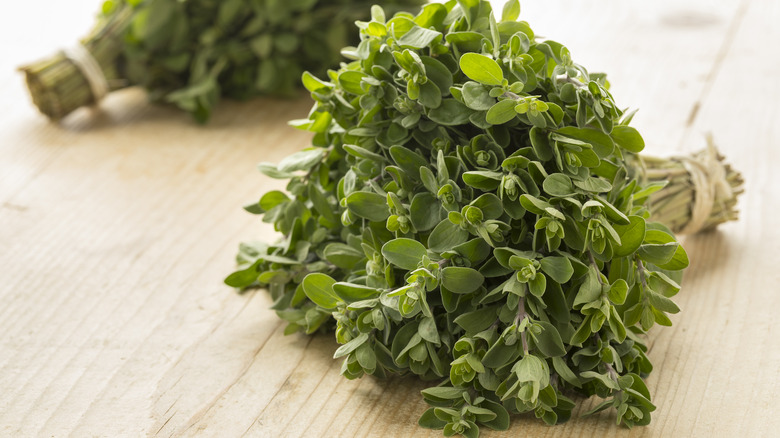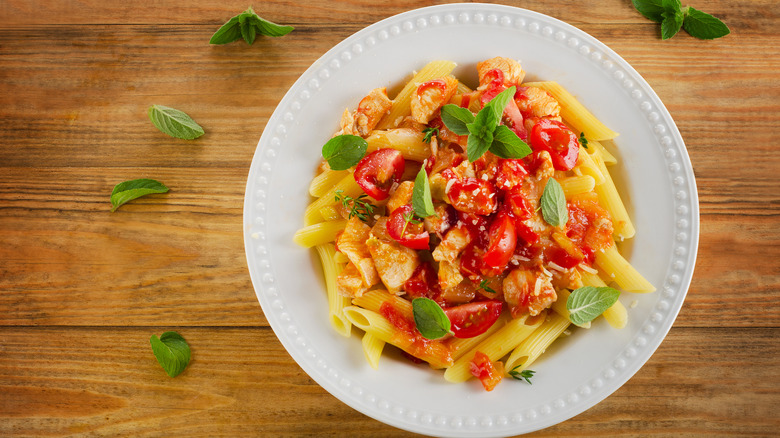The Mild Herb That Deserves A Place In Your Spice Blends
Either you have a friend with more spices and herbs than food in their house, or you are a friend with drawer upon drawer of spices. Whatever the occasion, you are prepared with whole cloves in hand, a mortar and pestle on the countertop, and you never leave the store without fresh basil. To live a well-seasoned life is to live a charmed life.
Eater reminds us that spice blends are in our kitchens to make our lives easier, whether we create them from scratch or purchase them from the store. Additionally, spice blends can be a lifesaver for the pocketbook. The cost to buy every ingredient you need for a quality spice blend can add up to a substantial sum, so buying pre-mixed spices and then a few essentials to add your own flair is much more economically feasible.
Whether you like to mix up your specialty barbecue rub or have an all-purpose spice blend ready for every occasion, mixing up your own herb and spice blend allows you to add your favorite flavors and nuances to a dish and bring your cooking to the next level. One herb you may not have heard of, but definitely should start adding to your grocery list, is marjoram. This herb is sure to be the next subtle secret ingredient that you'll want to add to all your recipes.
What is marjoram?
There are quite a few herbs that belong under the umbrella of the mint family and marjoram is one of them. Britannica tells us that marjoram (Origanum majorana) aka sweet marjoram is closely related to the more familiar herb, oregano, and has been used both dry and fresh for medicinal and culinary practices over the centuries. Described as aromatic, slightly sweet, and warm tasting, you may have been consuming the marjoram herb in a variety of foods like stews and salad dressings without even knowing it.
The herb itself is believed to be native to the Mediterranean and HerbaZest reports that according to lore, Aprhrodite blessed the plant with its scent and because of it, Greek and Roman brides would wear marjoram during their weddings to symbolize adoration and sweetness.
Marjoram has clearly been an essential part of spice blends for quite a while, but Gardener's Path points out that despite the fact that it was widely used in Europe, North Africa, and the Middle East, the herb didn't take off in the United States until the 20th century.
Marjoram vs. oregano
A plant that marjoram is compared to all too often is oregano. Oregano (Origanum vulgare) is also a part of the mint family and also goes by the name "wild marjoram" (via Britannica). Like marjoram, it is native to the Mediterranean and often used in many cultural dishes in the region.
According to MasterClass, the two herbs are very closely related and are often used in the same way, but they do have a few distinctions from one another. Oregano tends to taste more savory, while marjoram is characterized by a unique sweet flavor. This savory note is thanks to the abundance of the chemical compound carvacrol, which marjoram has considerably less of.
Sonoma Magazine tells us that marjoram is milder in pungency and is altogether characterized by a lighter, less intense profile. Oregano has a flavor that makes it essential to various multicultural spice blends and is quite common in Italian cuisine. Both marjoram and oregano have oval green leaves, making them difficult to tell apart when they grow wild, but in flavor, they are much more distinguishable.
How to use marjoram
Marjoram is soft in flavor and is perfect for bringing some complex savory characteristics to any dish without the worry of overwhelming it, according to Food Network. It has a lovely sweet undertone that balances well with most spices and is in season during the spring and summer (it is fairly sensitive to the cold). The herb can be used both fresh and dried in recipes and is the perfect herb to use in stews or on vegetables.
According to MasterClass, marjoram shines in tomato-based dishes like pizza, pasta, lasagna, and more, but you should consider using it in spice blends instead of by itself, so it can lend its nuanced flavor and round out your seasoning mixes. It is already a key ingredient in many people's favorite spice blends including French herbes de Provence and Middle Eastern za'atar. You should absolutely add it to your rubs and marinades for seafood and meats and even use it in your homemade salad dressing as a secret ingredient.
Nutrition
Healthline says that marjoram is known for being anti-inflammatory and antimicrobial and possibly helps with digestive issues, may reduce inflammation, and potentially regulates menstruation cycles. It's important to keep in mind that these are all "potential benefits" of the herb and more research needs to be done to know the true effects on humans (a few of these studies were done on rats).
If you are using the herb as a nutritional supplement, there are some side effects of taking it in large doses medicinally, including interacting with medications and causing pregnancy complications. You shouldn't worry if you're just using the herb for cooking in a small quantity.
That being said, we know for sure that marjoram contains essential vitamins (via Food Network) that boost bodily wellness including vitamins C, A, and K, which help reduce free radicals in the body, help with organ function, and are "needed for blood clotting and the building of bones," respectively.
Buying marjoram
You can find marjoram dried and fresh at grocery stores and farmers markets. If you wish to buy or harvest the herb from local farmers, The Royal Horticultural Society says that marjoram comes into season in the summer before the flower buds open when the flavor is most powerful.
If you choose to pick fresh marjoram instead of buying it dried, Food 52 recommends storing it in the refrigerator after wrapping the green stalks in a damp towel and enclosing it in plastic. And always remember to remove the leaves from the stems before adding it to your dishes. The leaves are what hold all the fragrant oils and flavors you want.
According to Epicurious, dried marjoram is just as good, if not more pronounced flavor-wise than the fresh herb. The dried stuff is more intense, so if you are looking to switch dried with fresh marjoram in a recipe or vice versa, remember that the fresh stuff will taste more delicate and you might require more of it to impart the flavor, and require less if you're using dried.





